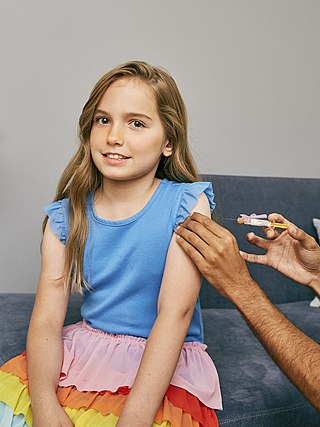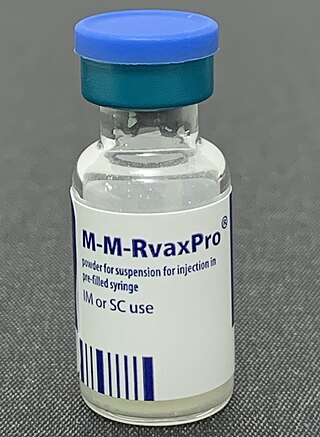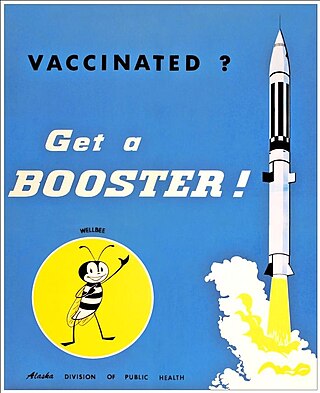Related Research Articles

Vaccination is the administration of a vaccine to help the immune system develop immunity from a disease. Vaccines contain a microorganism or virus in a weakened, live or killed state, or proteins or toxins from the organism. In stimulating the body's adaptive immunity, they help prevent sickness from an infectious disease. When a sufficiently large percentage of a population has been vaccinated, herd immunity results. Herd immunity protects those who may be immunocompromised and cannot get a vaccine because even a weakened version would harm them. The effectiveness of vaccination has been widely studied and verified. Vaccination is the most effective method of preventing infectious diseases; widespread immunity due to vaccination is largely responsible for the worldwide eradication of smallpox and the elimination of diseases such as polio and tetanus from much of the world. However, some diseases, such as measles outbreaks in America, have seen rising cases due to relatively low vaccination rates in the 2010s – attributed, in part, to vaccine hesitancy. According to the World Health Organization, vaccination prevents 3.5–5 million deaths per year.

A vaccine is a biological preparation that provides active acquired immunity to a particular infectious or malignant disease. The safety and effectiveness of vaccines has been widely studied and verified. A vaccine typically contains an agent that resembles a disease-causing microorganism and is often made from weakened or killed forms of the microbe, its toxins, or one of its surface proteins. The agent stimulates the body's immune system to recognize the agent as a threat, destroy it, and recognize further and destroy any of the microorganisms associated with that agent that it may encounter in the future.

The MMR vaccine is a vaccine against measles, mumps, and rubella, abbreviated as MMR. The first dose is generally given to children around 9 months to 15 months of age, with a second dose at 15 months to 6 years of age, with at least four weeks between the doses. After two doses, 97% of people are protected against measles, 88% against mumps, and at least 97% against rubella. The vaccine is also recommended for those who do not have evidence of immunity, those with well-controlled HIV/AIDS, and within 72 hours of exposure to measles among those who are incompletely immunized. It is given by injection.

The DPT vaccine or DTP vaccine is a class of combination vaccines against three infectious diseases in humans: diphtheria, pertussis, and tetanus (lockjaw). The vaccine components include diphtheria and tetanus toxoids, and either killed whole cells of the bacterium that causes pertussis or pertussis antigens. The term toxoid refers to vaccines which use an inactivated toxin produced by the pathogen which they are targeted against to generate an immune response. In this way, the toxoid vaccine generates an immune response which is targeted against the toxin which is produced by the pathogen and causes disease, rather than a vaccine which is targeted against the pathogen itself. The whole cells or antigens will be depicted as either "DTwP" or "DTaP", where the lower-case "w" indicates whole-cell inactivated pertussis and the lower-case "a" stands for "acellular". In comparison to alternative vaccine types, such as live attenuated vaccines, the DTP vaccine does not contain any live pathogen, but rather uses inactivated toxoid to generate an immune response; therefore, there is not a risk of use in populations that are immune compromised since there is not any known risk of causing the disease itself. As a result, the DTP vaccine is considered a safe vaccine to use in anyone and it generates a much more targeted immune response specific for the pathogen of interest.

Vaccine hesitancy is a delay in acceptance, or refusal, of vaccines despite the availability of vaccine services and supporting evidence. The term covers refusals to vaccinate, delaying vaccines, accepting vaccines but remaining uncertain about their use, or using certain vaccines but not others. The scientific consensus that vaccines are generally safe and effective is overwhelming. Vaccine hesitancy often results in disease outbreaks and deaths from vaccine-preventable diseases. Therefore, the World Health Organization characterizes vaccine hesitancy as one of the top ten global health threats.
A vaccine adverse event (VAE), sometimes referred to as a vaccine injury, is an adverse event believed to have been caused by vaccination. The World Health Organization (WHO) knows VAEs as Adverse Events Following Immunization (AEFI).
Artificial induction of immunity is immunization achieved by human efforts in preventive healthcare, as opposed to natural immunity as produced by organisms' immune systems. It makes people immune to specific diseases by means other than waiting for them to catch the disease. The purpose is to reduce the risk of death and suffering, that is, the disease burden, even when eradication of the disease is not possible. Vaccination is the chief type of such immunization, greatly reducing the burden of vaccine-preventable diseases.

A booster dose is an extra administration of a vaccine after an earlier (primer) dose. After initial immunization, a booster provides a re-exposure to the immunizing antigen. It is intended to increase immunity against that antigen back to protective levels after memory against that antigen has declined through time. For example, tetanus shot boosters are often recommended every 10 years, by which point memory cells specific against tetanus lose their function or undergo apoptosis.

Pneumococcal vaccines are vaccines against the bacterium Streptococcus pneumoniae. Their use can prevent some cases of pneumonia, meningitis, and sepsis. There are two types of pneumococcal vaccines: conjugate vaccines and polysaccharide vaccines. They are given by injection either into a muscle or just under the skin.
Immunization during pregnancy is the administration of a vaccine to a pregnant individual. This may be done either to protect the individual from disease or to induce an antibody response, such that the antibodies cross the placenta and provide passive immunity to the infant after birth. In many countries, including the US, Canada, UK, Australia and New Zealand, vaccination against influenza, COVID-19 and whooping cough is routinely offered during pregnancy.

Hepatitis B vaccine is a vaccine that prevents hepatitis B. The first dose is recommended within 24 hours of birth with either two or three more doses given after that. This includes those with poor immune function such as from HIV/AIDS and those born premature. It is also recommended that health-care workers be vaccinated. In healthy people, routine immunization results in more than 95% of people being protected.
Claims of a link between the MMR vaccine and autism have been extensively investigated and found to be false. The link was first suggested in the early 1990s and came to public notice largely as a result of the 1998 Lancet MMR autism fraud, characterised as "perhaps the most damaging medical hoax of the last 100 years". The fraudulent research paper, authored by discredited former doctor Andrew Wakefield and published in The Lancet, falsely claimed the vaccine was linked to colitis and autism spectrum disorders. The paper was retracted in 2010 but is still cited by anti-vaccine activists.
A vaccination policy is a health policy adopted in order to prevent the spread of infectious disease. These policies are generally put into place by state or local governments, but may also be set by private facilities, such as workplaces or schools. Many policies have been developed and implemented since vaccines were first made widely available.
Meningococcal vaccine refers to any vaccine used to prevent infection by Neisseria meningitidis. Different versions are effective against some or all of the following types of meningococcus: A, B, C, W-135, and Y. The vaccines are between 85 and 100% effective for at least two years. They result in a decrease in meningitis and sepsis among populations where they are widely used. They are given either by injection into a muscle or just under the skin.
The Lancet MMR autism fraud centered on the publication in February 1998 of a fraudulent research paper titled "Ileal-lymphoid-nodular hyperplasia, non-specific colitis, and pervasive developmental disorder in children" in The Lancet. The paper, authored by now discredited and deregistered Andrew Wakefield, and twelve coauthors, falsely claimed causative links between the measles, mumps, and rubella (MMR) vaccine and colitis and between colitis and autism. The fraud was exposed in a lengthy Sunday Times investigation by reporter Brian Deer, resulting in the paper's retraction in February 2010 and Wakefield being struck off the UK medical register three months later. Wakefield reportedly stood to earn up to US$43 million per year selling diagnostic kits for a non-existent syndrome he claimed to have discovered. He also held a patent to a rival vaccine at the time, and he had been employed by a lawyer representing parents in lawsuits against vaccine producers.
Extensive investigation into vaccines and autism has shown that there is no relationship between the two, causal or otherwise, and that vaccine ingredients do not cause autism. Vaccinologist Peter Hotez researched the growth of the false claim and concluded that its spread originated with Andrew Wakefield's fraudulent 1998 paper, with no prior paper supporting a link.
Helen Aspasia Petousis-Harris is a New Zealand vaccinologist and associate professor in the Department of General Practice and Primary Health Care at the University of Auckland. She has been involved in research related to vaccination in New Zealand since 1998, with her main areas of focus being vaccine safety and effectiveness. Petousis-Harris has had a variety of lead roles in New Zealand and international organisations that focus on vaccination and is a regular media spokesperson in this field, especially during the COVID-19 pandemic.
Misinformation related to immunization and the use of vaccines circulates in mass media and social media in spite of the fact that there is no serious hesitancy or debate within mainstream medical and scientific circles about the benefits of vaccination. Unsubstantiated safety concerns related to vaccines are often presented on the internet as being scientific information. A high proportion of internet sources on the topic are "inaccurate on the whole" which can lead people searching for information to form "significant misconceptions about vaccines".
The National Advisory Committee on Immunization is an advisory body that provides the Government of Canada with medical and scientific advice relating to human immunization.
The Australian Technical Advisory Group on Immunisation (ATAGI) is a technical advisory group of the Australian Government. As part of the Department of Health, ATAGI provides advice to the Minister of Health on the immunisation program of Australia and related matters, including the strength of evidence pertaining to existing, new, and emerging vaccines.
References
- 1 2 Gorski, David (22 February 2021). "Can mRNA-based COVID-19 vaccines cause prion disease or Alzheimer's?". Science-Based Medicine. Retrieved 11 April 2021.
- ↑ Lon Morgan. "John B. Classen". Fearmongers. Retrieved 2013-10-19.
- ↑ "Classen Immunotherapies". Vaccines.net. 2011-08-31. Archived from the original on 2018-10-11. Retrieved 2013-10-19.
- ↑ Classen, J. B.; Classen, D. C. (2002). "Clustering of cases of insulin dependent diabetes (IDDM) occurring three years after hemophilus influenza B (HiB) immunization support causal relationship between immunization and IDDM". Autoimmunity. 35 (4): 247–253. doi:10.1080/08916930290028175. PMID 12482192. S2CID 24765639.
- ↑ Classen, J. B. (1996). "The timing of immunization affects the development of diabetes in rodents". Autoimmunity. 24 (3): 137–145. doi:10.3109/08916939608995359. PMID 9020406.
- ↑ Himmelman, Khaya (8 April 2021). "Could the mRNA Vaccines Lead to an Increase in Neurodegenerative Disorders?". The Dispatch . Retrieved 8 April 2021.
- ↑ Funke, Daniel (26 February 2021). "The coronavirus vaccine doesn't cause Alzheimer's, ALS". Politifact. The Poynter Institute. Retrieved 11 April 2021.
- ↑ Kasprak, Alex (April 26, 2021). "Did Scientists 'Confirm' the Pfizer Vaccine Causes Neurological Damage?". Snopes . Retrieved 30 April 2021.
- ↑ Neustaedter, Randall (1996). The Vaccine Guide: Risks and Benefits for Children and Adults. North Atlantic Books. p. 56. ISBN 9781556434235.
- ↑ Wallace, Amy (19 October 2009). "How to Win an Argument About Vaccines". Wired . Vol. 17, no. 11. Retrieved 19 October 2013.
- ↑ Destefano, F.; Mullooly, J. P.; Okoro, C. A.; Chen, R. T.; Marcy, S. M.; Ward, J. I.; Vadheim, C. M.; Black, S. B.; Shinefield, H. R.; Davis, R. L.; Bohlke, K.; Vaccine Safety Datalink, T. (2001). "Childhood Vaccinations, Vaccination Timing, and Risk of Type 1 Diabetes Mellitus". Pediatrics. 108 (6): e112. doi:10.1542/peds.108.6.e112. PMID 11731639.
- ↑ Karvonen, M.; Cepaitis, Z.; Tuomilehto, J. (1999). "Association between type 1 diabetes and Haemophilus influenzae type b vaccination: Birth cohort study". BMJ. 318 (7192): 1169–1172. doi:10.1136/bmj.318.7192.1169. PMC 27850 . PMID 10221937.
- ↑ "Diabetes and vaccines" (PDF). Fact Sheet. National Centre for Immunisation Research and Surveillance. January 2007. Archived from the original (PDF) on 2013-10-19. Retrieved 2013-10-19.
- ↑ Staff (15 May 2014). "The Anti-Vaccine Movement Gains Traction, Ignoring The Science". Acsh.org.
- ↑ Classen (20 August 2022). "COVID-19 and Illegal US Bioweapons Activity, an Insider's Revelations" (PDF). Scivision Publishers (published 27 September 2022).
- ↑ Hayden, Erika Check (28 September 2011). "'Patent trolls' target biotechnology firms". Nature News. 477 (7366). Nature: 521. Bibcode:2011Natur.477..521C. doi: 10.1038/477521a . PMID 21956308. S2CID 36566313.